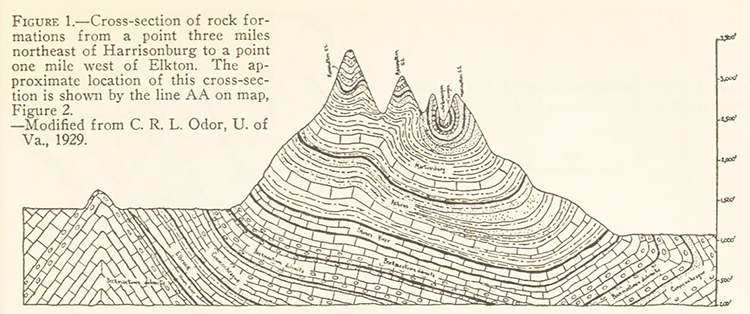1 December 2023
Friday fold: a Massanutten cross-section from a century ago
Posted by Callan Bentley
Happy Friday, friends!
Here’s an image I came across this week while searching for something else. It’s from a 1935 issue of The Virginia Teacher that describes the geology of the Massanutten mountain system for the benefit of students at James Madison University (then the State Teachers College at Harrisonburg) climbing the mountain on the weekends. The breezy article includes several illustrations, but I was particularly taken with this one, a modified reproduction of a 1929 sketch.
Here it is:
I’ve written a lot here about the geology of Massanutten, having lived in the depths of its differentially-eroded doubly-plunging synclinorium for 8 years. But this was the first time I’d seen this image. I like how it puts emphasis on the lower elevation of the Page Valley (right/east) relative to the Shenandoah Valley (left/west). I also note the overturned strata in the furthest east (right) position, something I’ve also documented on this blog.
The article accompanying the sketch describes the ridge forming layer as the Tuscarora (rather than the Massanutten Sandstone), which is out of vogue these days (but I think ultimately correct). In terms of interpretation and elucidation, one thing the article did really well was emphasize that though the entire Great Valley is a vast syncline in structure, and Massanutten Mountain is the deepest part of that structure, and those brings the youngest strata (Tuscarora/Massanutten) to the lowest level anywhere along the strike of that Great fold. Ironically, this results in the highest topographic elevations along the Great Valley, because of the Masscarora’s terrific resistance to weathering and erosion.
That Tuscanutten is really somethin’!



 Callan Bentley is Associate Professor of Geology at Piedmont Virginia Community College in Charlottesville, Virginia. He is a Fellow of the Geological Society of America. For his work on this blog, the National Association of Geoscience Teachers recognized him with the James Shea Award. He has also won the Outstanding Faculty Award from the State Council on Higher Education in Virginia, and the Biggs Award for Excellence in Geoscience Teaching from the Geoscience Education Division of the Geological Society of America. In previous years, Callan served as a contributing editor at EARTH magazine, President of the Geological Society of Washington and President the Geo2YC division of NAGT.
Callan Bentley is Associate Professor of Geology at Piedmont Virginia Community College in Charlottesville, Virginia. He is a Fellow of the Geological Society of America. For his work on this blog, the National Association of Geoscience Teachers recognized him with the James Shea Award. He has also won the Outstanding Faculty Award from the State Council on Higher Education in Virginia, and the Biggs Award for Excellence in Geoscience Teaching from the Geoscience Education Division of the Geological Society of America. In previous years, Callan served as a contributing editor at EARTH magazine, President of the Geological Society of Washington and President the Geo2YC division of NAGT.
I have done Civil War tourism around every flank of Massanutten but this is my first peek inside.
Thank you
I really enjoyed watching the field trip with the students, showing the cross-section of the synclinorium.
Think I’ll go hiking up the buzzards rock.
Been thinking about it for a long time. I used to work for US geological survey. Got my PhD in geology in the 1980s, but have not done a lot with it since. Your field trip reminds me of how much I loved the Appalachians, especially the valley and ridge. Thank you.
I’ve seen that ridge and valley topography flying from Miami to Chicago. Fun to see it in cross section. Thanks for all your posts on this geology.